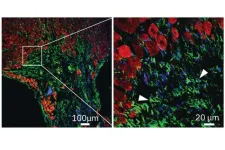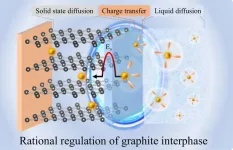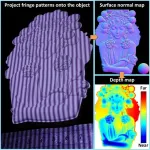(Press-News.org) Using a few zaps of electricity to the skin, researchers can stop bacterial infections without using any drugs. For the first time, researchers designed a skin patch that uses imperceptible electric currents to control microbes. The results appear October 24 in the Cell Press journal Device.
“This opens up exciting possibilities for drug-free treatments, especially for skin infections and wound healing, where antibiotic-resistant bacteria pose a serious challenge,” says University of Chicago’s Bozhi Tian, one of the paper’s co-senior authors.
Scientists have already been using electricity to manipulate mammalian cells, including those of humans, and to treat diseases without using medicine. For example, pacemakers can regulate heartbeats by stimulating heart muscles with small electric currents. Retina prosthesis, a type of bionic eye, also uses electricity to stimulate a patient’s retina to partially restore their vision.
Tian and his team wondered if they could manipulate bacteria using electricity instead of antibiotics, a traditional approach that gave rise to the global antibiotic resistance crisis. Due to antibiotic overuse in humans and livestock, many microbes have evolved and become resistant to current drugs, rendering them less effective over time. Previous studies estimate that drug-resistant infections might have contributed to about 1.27 million deaths worldwide in 2019.
The team set out to test if Staphylococcus epidermidis, a common bacterium on human skin, would respond to electrical stimulations. S. epidermidis is generally harmless and can even protect the skin from pathogens. But when it enters the human body through a cut or medical procedure, such as a catheter, it can cause serious infections. Recently, three strains of S. epidermidis resistant to all classes of antibiotics have emerged.
“Because Staphylococcus is part of the microbial ecosystem that naturally exists on our skin, we prefer not to eradicate it, since their complete absence on our skin could cause other problems” says the paper’s other co-senior author Gürol Süel of the University of California San Diego.
The team found that small electric currents can elicit responses from S. epidermidis, but only in an acidic environment. The researchers call this characteristic selective excitability. Healthy human skin is mildly acidic, but chronic wounds tend to be neutral to basic.
“Bacteria’s response to electricity isn’t well explored, partially because we don’t know the specific conditions under which bacteria will be excited,” says first author Saehyun Kim, also of the University of Chicago. “Discovering this selective excitability will help us discover how to control other bacteria species by looking at different conditions.”
The team stimulated the bacterium with a weak electric voltage of 1.5 volts—significantly lower than the 15-volt limit deemed imperceptible and safe for humans—for 10 seconds every 10 minutes for 18 hours. Under the ideal acidic condition, the electricity treatment stopped 99% of the biofilm, a cluster of bacteria that blocks drugs and leads to persistent infections. When the environment pH is neutral, the treatment showed no effects.
Further analysis also revealed that after electrical stimulation, the S. epidermidis showed a decrease in the expression of several genes, including those related to antibiotic resistance and biofilm formation.
In order to treat skin wounds by stimulating S. epidermidis under the right condition, the team designed a skin patch, called Bioelectronic Localized Antimicrobial Stimulation Therapy, or BLAST. The patch contains electrodes and a hydrogel to provide an acidic environment. They tested the device on a pork skin inoculated with S. epidermidis. After the 18-hour treatment cycle, the team observed a significant decrease in biofilm coverage and nearly 10 times reduction in S. epidermidis cells compared to the untreated sample. They also tested the device on the surface of a catheter and saw the same antimicrobial effect.
Tian says that with further research to examine the safety and effectiveness of this treatment, scientists could develop a wearable patch with a wireless circuit to control infections without drugs.
###
The work is supported by the Bill & Melinda Gates Foundation, US Army Research Office, the National Science Foundation, the National Institutes of Health.
Device, Kim et al.: “Bioelectronic drug-free control of opportunistic pathogens through selective excitability.” https://www.cell.com/device/fulltext/S2666-9986(24)00542-8
Device (@Device_CP) is a physical science journal from Cell Press along with Chem, Joule, and Matter. Device aims to be the breakthrough journal to support device- and application-oriented research from all disciplines, including applied physics, applied materials, nanotechnology, robotics, energy research, chemistry, and biotechnology, under a single title that focuses on the integration of these diverse disciplines in the creation of the cutting-edge technology of tomorrow. Visit https://www.cell.com/device/home. To receive Cell Press media alerts, contact press@cell.com.
END
About The Study: These interim findings demonstrate the feasibility of targeted interpretation of a predefined set of genes from genome sequencing in a population of different racial and ethnic groups. DNA sequencing offers an additional method to improve screening for conditions already included in newborn screening and to add those that cannot be readily screened because there is no biomarker currently detectable in dried blood spots. Additional studies are required to understand if these findings are generalizable to populations of different racial and ethnic groups and ...
Early results from a study of newborn screening methods show that DNA analysis picks up many more preventable or treatable serious health conditions than standard newborn screening and is favored by most parents who are offered the option.
The study—called GUARDIAN—is one of the first large-scale studies in the world to use genome sequencing as a method for newborn screening and is the first to publish preliminary results.
“The results show us that genome sequencing can radically improve children’s medical care,” says Joshua Milner, professor of Pediatrics, director of Allergy/Immunology and Rheumatology ...
About The Study: In this cohort study, non-Hispanic Black race was associated with increased odds of not receiving guideline-concordant care (GCC) and less timely treatment initiation. Non-Hispanic Black race was associated with increased all-cause mortality, which was reduced after adjusting for GCC and clinical and sociodemographic factors. These findings suggest that optimizing timely receipt of GCC may represent a modifiable pathway to improving inferior survival outcomes among older non-Hispanic Black ...
About The Study: This cross-sectional study found that absolute concentrations of fentanyl, methamphetamine, and cocaine in urine specimens increased from 2013 to 2023, with a decrease in heroin concentration during that period. The findings suggest that exposure to these substances, as well as the illicit drug supply, has fundamentally changed in many parts of the U.S., highlighting the need to reinforce surveillance initiatives and accelerate efforts to treat individuals with illicitly manufactured fentanyl and/or stimulant exposure.
Corresponding Author: To ...
Scientists at the Eli and Edythe Broad Center of Regenerative Medicine and Stem Cell Research at UCLA have developed a first-of-its-kind experimental therapy that has the potential to enhance heart repair following a heart attack, preventing the onset of heart failure.
Cardiovascular disease continues to be the world’s leading cause of death, contributing to one-third of deaths annually. After a heart attack, the heart’s innate ability to regenerate is limited, causing the muscle to develop scars to maintain its structural integrity. ...
HOUSTON ― Researchers from The University of Texas MD Anderson Cancer Center demonstrated that anti-PD-L1 immunotherapy in combination with mutation-directed targeted therapy extended overall survival (OS) in patients with anaplastic thyroid carcinoma (ATC). Findings from the Phase II single center study published today in JAMA Oncology.
The trial enrolled 42 patients across three cohorts to evaluate mutation-matched targeted therapy and the immune checkpoint inhibitor atezolizumab. The median OS across all cohorts was 19 months, which compares favorably to historical OS of five months for patients with ATC. ...
Producing materials such as steel, plastics and cement in the United States alone inflicts $79 billion a year in climate-related damage around the world, according to a new study by engineers and economists at the University of California, Davis. Accounting for these costs in market prices could encourage progress toward climate-friendly alternatives.
“We wanted to look at the cost to society to produce these materials,” said Elisabeth Van Roijen, a recent Ph.D. graduate from the UC Davis Department of Civil and Environmental Engineering ...
On-demand ride services or ride-sourcing services have been experiencing fast development and steadily reshaping the way people travel in the past decade. Various optimization algorithms, including reinforcement learning approaches, have been developed to help ride-sourcing platforms design better operational strategies to achieve higher efficiency. However, due to cost and reliability issues, it is commonly infeasible to validate these models and train/test these optimization algorithms within real-world ride-sourcing platforms. Acting as a proper test bed, a simulation platform for ride-sourcing systems will thus be essential for both ...
A team of researchers has undertaken a study of the future of carbon anodes for lithium-ion batteries. Their review provides a comprehensive overview of the progression in carbon anode development and the current status of their industrialization. This study underscores the critical role of interphase regulation engineering in advancing lithium-ion battery technology.
Their research is published in the journal Carbon Future on September 24, 2024.
Today, graphite is the most commonly used material for anodes in lithium-ion batteries. Graphite can operate at a low voltage, is readily available, and cost effective. While graphite materials ...
WASHINGTON — Researchers have developed a faster and more accurate method for acquiring and reconstructing high-quality 3D surface measurements. The approach could greatly improve the speed and accuracy of surface measurements used for industrial inspection, medical applications, robotic vision and more.
“Traditional 3D imaging works by comparing two viewpoints, similar to how our eyes work together to judge depth,” said research team leader Ce Zhu from the University of Electronic Science and Technology of China. “In contrast, our new approach ‘feels’ the surface by projecting light ...




